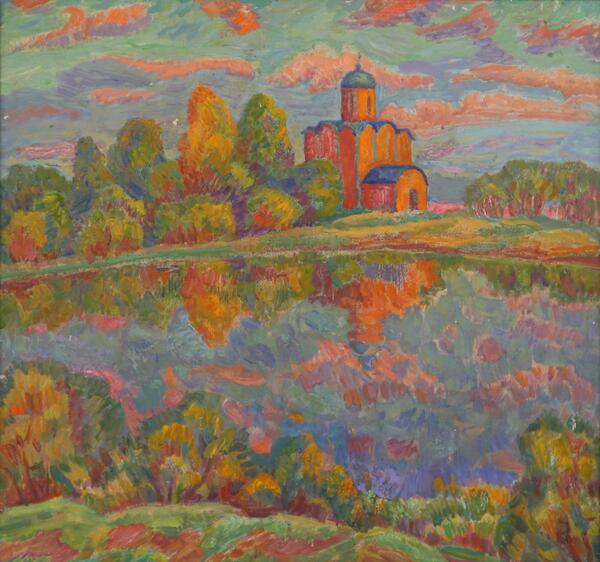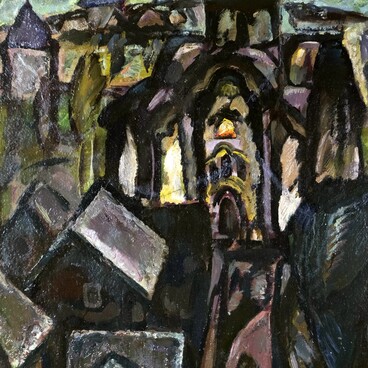The small Transfiguration Monastery in Kovalyovo was erected in the suburbs of Novgorod on the right bank of the Volkhovets River.
Its catholicon (main church) — the Church of the Transfiguration, or the Church of the Savior in Kovalyovo — was erected in 1345 with the blessing of Archbishop Basil and by order of boyar Ontsifor Zhabin: “Okinfa Zhabin laid the Church of the Holy Savior in Kovalev.”
Probably, Ontsifor Zhabin is Ontsifor Lukin, mentioned several times in chronicles. He could have been nicknamed “Zhabin” in 1348 after a battle on the “Zhabtse field” (“zhaba” in Russian means a “frog”) with the troops of the Swedish king Magnus VIII Eriksson, who wanted to convert the Izhorians (a Finnic indigenous people) to his faith.
In 1380, under Archbishop Alexy, by order of boyar Afanasy Stepanovich and his wife Maria, the church was decorated with frescoes. The images on them of Anthony the Great, nuns and scenes of monastic life prove that the church and monastery were constructed at the same time.
It is known from chronicles that in 1500 the hegumen of the monastery in Kovalyovo participated in the procession around the restored Novrogod Kremlin (Detinets). In 1582, after the Livonian War, only one of the sixteen cells was inhabited, where the elder Irenarch lived.
In 1624, Tsar Mikhail of Russia granted the Transfiguration Monastery a charter to own land in Spassky and Shugozersky areas in Obonezhskaya Pyatina.
The monastery ensemble included two churches: the stone Transfiguration Church with the Annunciation Chapel and the wooden Trinity Church with the St. Nicholas Chapel.
During the 17th-century Swedish invasion, the monastery was almost destroyed, and in 1764, like many others, it was abolished due to the church and land reform of Catherine II. Historians inherited detailed inventories of monastic property compiled shortly before and immediately after this event.
In the early 20th century, as the newspaper “Zvezda” (“Star”) wrote in 1925, the foundations of the buildings were still preserved on the territory of the monastery; later they were sold to the Monastery of the Holy Spirit as materials to pave a road.
In the 1910s, experts began to restore the frescoes (the restorer Nikolay Petrovich Sychev finished the work). Already at that time, some of them were completely lost and could not be restored, the rest were photographed.
However, divine services continued in the Transfiguration Church until the 1930s. During the Great Patriotic War, located on the defensive line of the Volkhov Front, and after the war, 70 percent of the church was destroyed.
From 1962 to 1974, work was carried out to recreate the complex and frescoes, thanks to which the church is now restored.
Vasily Makarovich Chekhonadsky’s painting vividly reflected the wide perspective, the artistic and conceptual unity of nature and architecture, and the expressive relief brushwork, characteristic of his style.
Its catholicon (main church) — the Church of the Transfiguration, or the Church of the Savior in Kovalyovo — was erected in 1345 with the blessing of Archbishop Basil and by order of boyar Ontsifor Zhabin: “Okinfa Zhabin laid the Church of the Holy Savior in Kovalev.”
Probably, Ontsifor Zhabin is Ontsifor Lukin, mentioned several times in chronicles. He could have been nicknamed “Zhabin” in 1348 after a battle on the “Zhabtse field” (“zhaba” in Russian means a “frog”) with the troops of the Swedish king Magnus VIII Eriksson, who wanted to convert the Izhorians (a Finnic indigenous people) to his faith.
In 1380, under Archbishop Alexy, by order of boyar Afanasy Stepanovich and his wife Maria, the church was decorated with frescoes. The images on them of Anthony the Great, nuns and scenes of monastic life prove that the church and monastery were constructed at the same time.
It is known from chronicles that in 1500 the hegumen of the monastery in Kovalyovo participated in the procession around the restored Novrogod Kremlin (Detinets). In 1582, after the Livonian War, only one of the sixteen cells was inhabited, where the elder Irenarch lived.
In 1624, Tsar Mikhail of Russia granted the Transfiguration Monastery a charter to own land in Spassky and Shugozersky areas in Obonezhskaya Pyatina.
The monastery ensemble included two churches: the stone Transfiguration Church with the Annunciation Chapel and the wooden Trinity Church with the St. Nicholas Chapel.
During the 17th-century Swedish invasion, the monastery was almost destroyed, and in 1764, like many others, it was abolished due to the church and land reform of Catherine II. Historians inherited detailed inventories of monastic property compiled shortly before and immediately after this event.
In the early 20th century, as the newspaper “Zvezda” (“Star”) wrote in 1925, the foundations of the buildings were still preserved on the territory of the monastery; later they were sold to the Monastery of the Holy Spirit as materials to pave a road.
In the 1910s, experts began to restore the frescoes (the restorer Nikolay Petrovich Sychev finished the work). Already at that time, some of them were completely lost and could not be restored, the rest were photographed.
However, divine services continued in the Transfiguration Church until the 1930s. During the Great Patriotic War, located on the defensive line of the Volkhov Front, and after the war, 70 percent of the church was destroyed.
From 1962 to 1974, work was carried out to recreate the complex and frescoes, thanks to which the church is now restored.
Vasily Makarovich Chekhonadsky’s painting vividly reflected the wide perspective, the artistic and conceptual unity of nature and architecture, and the expressive relief brushwork, characteristic of his style.





